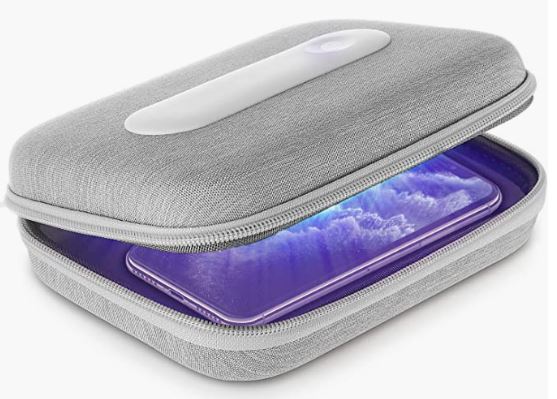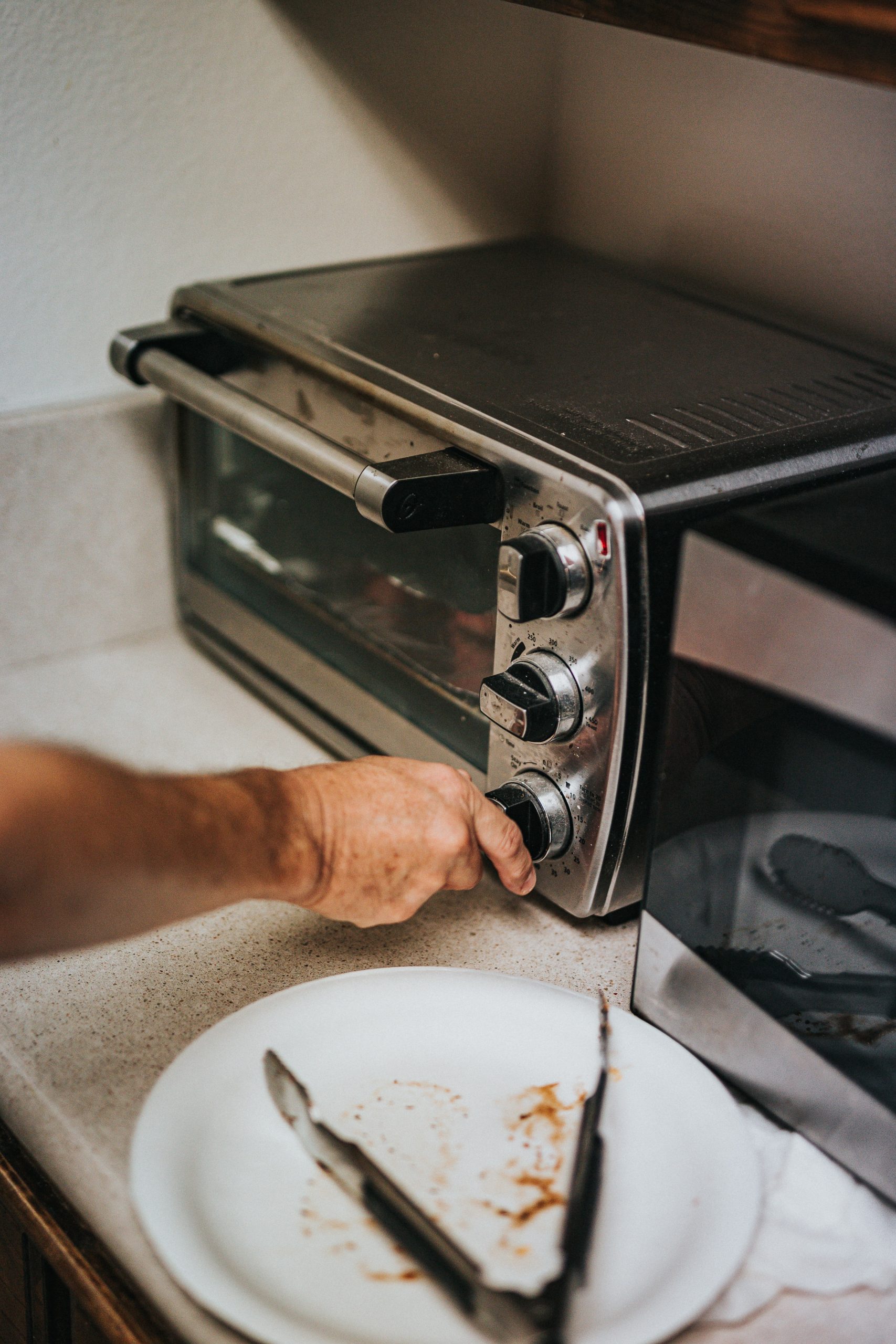Could we soon irradiate our own food at home using UV light?
When I first started researching ways to protect against Coronavirus, these little boxes for radiating your phone, keys, etc. seemed to be a very ingenious device.
They use UV-C light to kill germs on surfaces, claiming only “3 minutes per side” for “99.99% efficiency for maximum protection against microorganisms and airborne allergens.” One well-known brand name is called “Phonesoap”. Well, what about our food? Mold and mycotoxin illness have been around a lot longer than Coronavirus, but I have not seen a solution to eliminate these microbes from food in our homes. We are (mostly) content to let the food manufacturers and government to handle it. Shown on food packaging, the Radura is the international symbol indicating a food product has been irradiated. The Radura is usually green and resembles a plant in circle. The top half of the circle is dashed. (wikipedia.org)
Select foods are cleaned by radiation, but it’s a stronger, industrialized process than our Phonesoap example. This video by the International Atomic Energy Agency does a good job of explaining how it works. The weapon of choice is x-rays or gamma rays, which are electromagnetic radiation of shorter wavelengths than UV light. Foods can be sterilized in this way in their packaging, as a cold process that does not affect their color or taste and actually increases shelf life. There are 3 ways that foods can be irradiated: with X-rays, gamma rays or electron beam (e-beam), which is similar to x-rays (fda.gov). Besides the obvious foodborne illness that can be present with bacteria or viruses, it can destroy the mycotoxins (toxins produced from different mold organisms) that cause systemic sickness and even cancer (yikes!). If you are unfamiliar with mycotoxins, here is a post about them. Recently, I ran across this study that focused on aflatoxins, because of their frequency and potency in causing illness. “Mycotoxins are secondary metabolites of filamentous fungi, dangerous to both humans and animals. The most common mycotoxin-producing genera are Aspergillus, Fusarium, and Penicillium. The family of toxins produced by the fungi Aspergillus flavus and Aspergillius parasiticus pose the greatest danger to animal and human health. Aspergillus flavus is considered to be the most frequent source of aflatoxins in crops. As seed inhabiting fungi, Aspergillus parasiticus can contaminate a wide variety of crops, either before harvesting in the field or after harvest while being handled and processed. Naturally occurring aflatoxins are the aflatoxin B1 (AFB1), the most potent carcinogenic agent known, and the aflatoxins B2, G1, and G2 (aflatoxins B2 and G2 are dihydroxylated derivatives of B1 and G1).”
There are many studies on how irradiation affects mycotoxins, because efficacy of radiation depends on the strain of mycotoxin, strength of radiation, duration of radiation, and the type of food infected with the mycotoxin. For example, this 2008 study focused on aflatoxin B1 infection and irradiation of food crops (peanut, peeled pistachio, unpeeled pistachio, rice, and corn) and feed (barley, bran, corn). kGY is a unit of ionizing radiation and the samples were irradiated at 4, 6, and 10 kGy. It was determined that the high oil content of peanuts served as some kind of protection for the aflatoxin against radiation, because in peanuts, percentage of AFB1 degradation at 10 kGy was not more than 56.6%, whereas, the corresponding value in corn, which contained the lowest oil content, reached as high as 80%.
I’m glad that manufacturers can use irradiation on mycotoxin-prone food to make it safer to eat, because some of our tastiest foods (spices, chocolate and coffee) are some of the most susceptible to spoilage by mycotoxins! However, it’s not a process the average person can implement in their home, any more than we can buy an x-ray machine for our own use. This got me thinking: how effective is UV radiation on mycotoxins? UV-C is also a non-thermal treatment that doesn’t affect color or taste of the treated food. One key difference between irradiation by x-ray and gamma ray versus UV light is that the former method can penetrate through packaging and into the food, while UV light only sterilizes the surface of the food and depends on good illumination of the surface. Or does it? Another review on UV treatment of various foods admitted at the end that photon energy of the UV light has not been widely studied, and “Photons are likely to penetrate quite deep into the organic matter and thus this technique is not limited to surface effects. The penetration depth depends enormously on the photon energy (or the UV radiation wavelength). Low-energy UV photons (such as those from medium-pressure mercury lamps) penetrate deep into the organic matter, stimulate photo-oxidation, photo-degradation, and photo-elimination (or both), which was found beneficial for the degradation of aflatoxins. Not much research has been performed on the degradation of toxins using high-energy photons.”
Apparently, the results are varied. One study on irradiating pineapple sticks with UV-C showed that it did not “significantly affect total viable bacteria, yeast and mould counts. This result confirms the higher sensitivity of bacteria to UV-C light as compared to fungi (Koutchma, 2009)”, and also that the relatively “rough” surface of the pineapple sticks decreased the efficacy of irradiation. Increasing the intensity of the light also did not increase degradation of the yeasts or molds. However, the pineapple sticks, once they were treated and packaged in PET/EVOH/PE plastic trays, sealed with a PET/PE film and stored at 6 °C to simulate storage of fresh-cut fruit along the refrigerated chain, grew less yeasts than the control samples, indicating that UV-C irradiation helped to lengthen storage life. Molds were not affected between the control and irradiation samples, presumably because the pineapple off-gasses as it is stored, creating an anaerobic environment.
In this 2008 study in which two levels, mild and strong, UV radiation was used against feed-contaminating mycotoxins, even the mild radiation was effective in destroying the two types of mycotoxins within 60 minutes, but the stronger radiation performed more rapidly.
A review of many studies was made to compare UV, ozone and ammonia treatment of foods with mycotoxins for inactivating aflatoxins. Here are some results of the UV radiation studies:
- UV irradiation of 15 min of aflatoxin-contaminated semolina (wheat grain) could lead to the complete degradation of AFB1. A germicidal UV lamp with 30 W power providing UV-C radiation at 254 nm was used as a light source, and 100 g of the semolina layer of 1 cm thickness was exposed to the UV light at a distance of 15 cm.
- In hazelnuts that were artificially inoculated with Aspergillus, the effects of a 254 nm UV-C treatment were measured on aflatoxin production. A 2-log reduction in Aspergillus spp. counts and a 25% reduction in aflatoxins B1 and G1 were obtained with a 6 h (2 h periods repeated 3 times) UV-C (9.99 J/cm2 ) treatment (2 log reduction is equal to 99% reduction).
- Another approach to UV light irradiation is “pulsed light” technique, which has the advantages of a broad UV spectrum, a short duration, but high peak power. For example, instead of minutes or hours of UV treatment, pulsed light is used for seconds. Again, some strains of mycotoxins are more degraded by pulsed light than other strains, and in treatment of a water solution of mycotoxins, ochratoxin and aflatoxin B1 were more degraded than zearalenone and deoxynivalenol. In a study of rough rice and rice bran which were inoculated to grow aflatoxin B1 and B2, it was found that irradiation of the rice bran was more effective ( 90.3% and 86.7% on AFB1 and AFB2 respectively) than the rough rice (75.0% and 39.2%). This may be due to the surface characteristics, because rough rice is the whole rice kernel including the hull, and the rice bran is brown rice, which has the hull removed but still contains the bran. (feedipedia.org) Therefore, the stage of food processing is important for deciding when to apply radiation.
- Humidity of the foods under study is also important for mycotoxin degradation. A study of nuts that were inoculated with Aspergillus flavus, Aspergillus parasiticus, and Penicillium, showed that greater humidity = greater degradation. “The fungicidal activity of UV-C radiation was found to be more pronounced in the nuts treated at the higher 16% moisture level, with levels of efficiency in the following order: walnut > almond = pistachio > peanuts. A 45 min treatment resulted in 87% and 96% degradation of AFB1, depending on the moisture level, with the maximum reduction seen for almond and pistachio.”
At the end of this review, the authors confessed what was growingly apparent to me: 1. The destruction of toxins remains both a scientific and technological challenge. (In effect, it’s hard to determine the best standard treatment (intensity of light, duration and distance from food) when type and level of mycotoxin, type of food, and humidity level all come into play!) 2. The reported treatment times are prohibitively long for industrial application. (It should be obvious that treatment times in hours are not feasible for the many tons of feed and food processed every year, although pulsed light treatments of seconds may be.)
I’m not without hope, though, that like the “Phonesoap” box, we could soon have a “Foodsoap” box for home sterilization of foods with UV technology. Although tons of contaminated feed for livestock can still end up affecting humans that consume the livestock, it may be economically effective to disable mycotoxins at home on luxury grains like walnuts and pistachios because of their smaller volume and higher prices. I’m thinking that according to research, the UV light used could be of a specific, widely tested wavelength (like the 222nm we investigated in this post against SARS-CoV-2 virus and Staphylococcus aureus bacteria), with a humidistat to determine the water content of the food, and a dial setting for the type of food (thus in conjunction with the humidstat, the dial setting automatically gives the appropriate time and cycles of light pulses needed), and possibly an agitator that would turn the food between cycles in order to get better coverage/penetration. This device would of course be larger than a Phonesoap box, maybe more like the size of a toaster oven or food dehydrator. When considering that some of these mycotoxins can cause cancer, isn’t food safety way more important than an Air Fryer? I think it only takes education and time before we recognize the need for UV irradiation of foods at home, so that all of our minimally processed foods can be safe from mycotoxins.Photo by Andrew Valdivia on Unsplash



